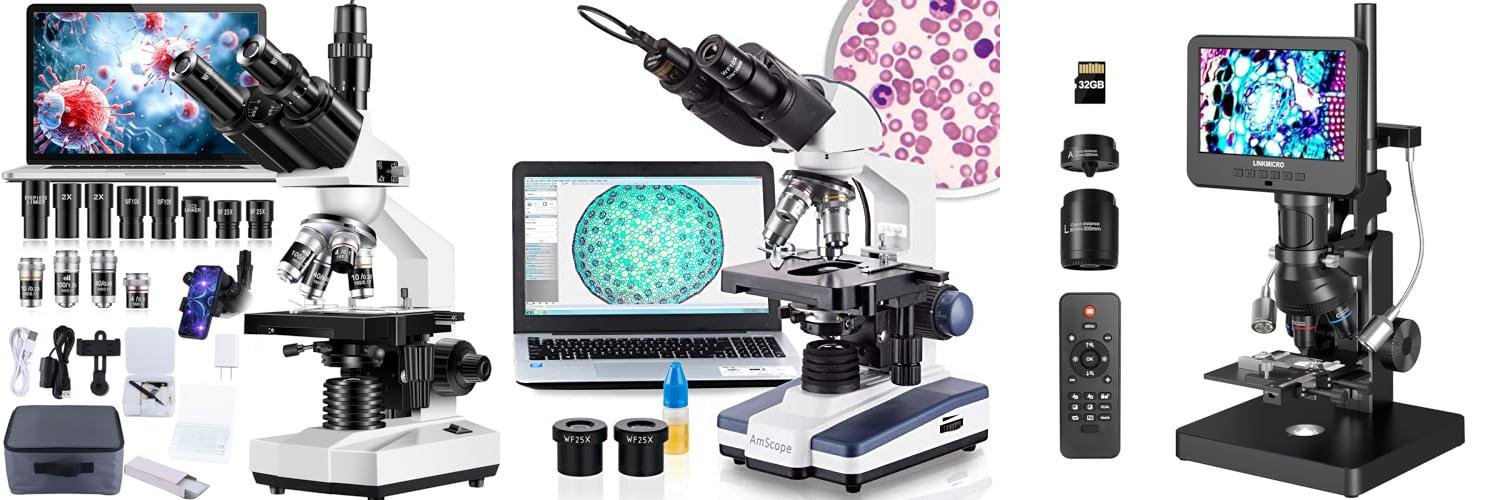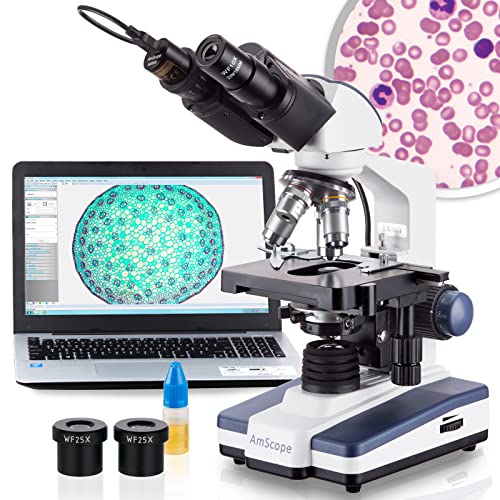Have you ever peered through a microscope and wished you could share the amazing things you saw? Maybe you wanted to show a friend the tiny creatures in pond water or document a cool science experiment. In today’s world, we often want to capture and share what we see, and that’s where a microscope with a camera comes in!
Choosing the right microscope with a camera can be tricky. There are so many types, from simple ones for kids to advanced models for professionals. It’s easy to feel overwhelmed by the different features, like resolution, magnification, and ease of use. Plus, the price tags can vary wildly! Finding the perfect balance of quality, features, and cost can feel like searching for a needle in a haystack.
This blog post is here to help! We’ll break down everything you need to know about microscopes with cameras. You’ll learn about the different types, what to look for, and how to choose the best one for your needs. Get ready to unlock a whole new world of discovery and easily share your microscopic adventures! Let’s dive in and explore the fascinating world of microscopes with cameras!
Our Top 5 Microscope With Camera Recommendations at a Glance
Top 5 Microscope With Camera Detailed Reviews
1. Trinocular Microscope 40X-5000X Magnification Laboratory Grade with Dual Mechanical Stage and HD USB Camera Microscope for Adults
Rating: 8.9/10
Explore the microscopic world with the Trinocular Microscope! This laboratory-grade microscope offers amazing magnification from 40X to 5000X. It comes with a dual mechanical stage and an HD USB camera. It’s designed for adults and perfect for learning and professional use. The microscope has wide-angle eyepieces and a high-quality objective lens for clear images. The 8-core design includes LED lighting and easy focusing. A great gift, it comes with a complete set of accessories for immediate use.
What We Like:
- High magnification range (40X-5000X) allows you to see tiny details.
- Wide-angle eyepieces and adjustable features make viewing comfortable.
- The 195 objective lens provides sharp and clear images.
- The included accessories, like slides and coverslips, make it ready to use.
- It is suitable for many different uses, from school to professional work.
What Could Be Improved:
- No information about the HD USB camera quality
This Trinocular Microscope is a powerful tool for anyone interested in microscopy. It’s a great choice for science enthusiasts and professionals alike.
2. AmScope B120 Series Student & Professional LED Binocular Compound Microscope – 40X-2500X Magnification – Includes 5MP USB Camera & Siedentopf Head
Rating: 9.4/10
The AmScope B120 Series is a top-notch binocular compound microscope. It is great for students and professionals. This microscope offers magnifications from 40X to 2500X. It has a 5MP USB camera. It also has a Siedentopf head. This makes it perfect for labs, clinics, and classrooms. AmScope is known for its high-quality microscopes and accessories.
What We Like:
- It’s an economical choice for many users.
- The magnification range is excellent for various applications.
- The LED light gives bright and even illumination.
- The included 5MP USB camera allows you to take pictures and videos.
- The professional software helps analyze images.
What Could Be Improved:
- Some users may find the initial setup a little tricky.
- The included software has a learning curve.
The AmScope B120 Series is a powerful microscope for its price. It’s a great choice for students and professionals looking for a versatile and feature-rich option.
3. LINKMICRO LM266S 5 Lens HDMI Digital Microscope 5000X for Adults
Rating: 8.7/10
The LINKMICRO LM266S is a super cool digital microscope! It’s like having three microscopes in one. You can look at coins, tiny bugs, and even circuit boards. It has a big screen and can take pictures and videos. This microscope is great for adults who like to explore the small things in life.
What We Like:
- It has five different lenses for all sorts of uses. You can look at coins, slides, and even solder things!
- The mechanical stage helps you move things around easily.
- You can connect it to a bigger screen using HDMI. This is great for sharing what you see.
- It has a bright 7-inch screen. You can see all the details!
- You can take pictures and videos, and save them on the included memory card.
- The lights are adjustable. You can see things clearly.
What Could Be Improved:
- Some users might find it a bit tricky to set up at first.
- The price might be a bit high for some people.
The LINKMICRO LM266S is a powerful microscope with many cool features. If you want to explore the tiny world, this microscope is a great choice.
4. Swift SW350T Compound Trinocular Microscope
Rating: 9.2/10
The Swift SW350T is a powerful microscope. It has a trinocular head and a 5.0MP camera. This microscope is perfect for students, clinicians, and hobbyists. You can see tiny details of specimens. The microscope comes with prepared and blank slides. It also includes software for Windows and Mac computers.
What We Like:
- The microscope has six magnification levels. You can view things from 40X to 2500X.
- The Siedentopf head rotates. This makes it easy for multiple people to use.
- The angled eyepieces are comfortable. They reduce neck strain.
- The bright LED light shines through the specimen.
- The included camera lets you view, record, and capture images.
- The software works on both Windows and Mac computers.
- The microscope comes with prepared and blank slides.
What Could Be Improved:
- Some users may find the setup a little complex.
- The included instructions could be clearer.
Overall, the Swift SW350T is a great microscope. It is a good choice for many users. This microscope is well-equipped for various scientific applications.
5. LCD Digital Microscope
Rating: 9.3/10
Explore the tiny world with the LCD Digital Microscope! This microscope has a 4.3-inch screen and a 1080P camera. It magnifies objects from 50X to 1000X. You can record videos and take pictures. This microscope is great for looking at plants, coins, and circuits. It’s easy to use and fun for everyone.
What We Like:
- The 4.3-inch screen shows clear images.
- It has 1000X magnification to see small details.
- You can record videos and take photos.
- The built-in lights help you see better.
- It comes with a 32GB SD card to save your work.
- It’s easy to focus and use.
- It’s portable and can be used without a stand.
What Could Be Improved:
- The microscope is not for medical use.
This LCD Digital Microscope is a great tool for learning and exploring. It’s a fun way to see the world up close and discover new things!
Microscope with Camera: Your Guide to Seeing the Small World
Are you curious about the tiny things around you? A microscope with a camera lets you explore! You can see details you never imagined. This guide helps you choose the right one.
1. Key Features to Look For
You need to know what to look for. These features make a big difference:
- Magnification: How big can it make things appear? Look for a range. Higher magnification shows more detail. But you might not need super high power.
- Camera Resolution: This tells you how clear the pictures will be. It’s measured in megapixels (MP). More MP means better pictures.
- Type of Microscope: There are different types. A compound microscope uses light to see through thin objects. A digital microscope often uses a USB connection.
- Built-in or Detachable Camera: Some have the camera inside. Others have a camera you can remove. Think about how you want to use it.
- Focusing System: A good focusing system makes it easy to get a clear picture. Look for fine and coarse focus knobs.
- Illumination: How does it light up the object? LED lights are common. They are bright and don’t get too hot.
2. Important Materials
The materials tell you about the quality:
- Objective Lenses: These are the lenses closest to the object. They should be made of good quality glass.
- Body Materials: A sturdy base is important. Metal bases are often better than plastic.
- Stage: The stage holds the slide. It should move smoothly.
3. Factors That Improve or Reduce Quality
Some things make a microscope great. Other things can make it less useful:
- Quality of Lenses: Sharp lenses give clear images. Cheap lenses can be blurry.
- Light Source: Bright and even lighting helps you see.
- Build Quality: A well-built microscope lasts longer. It’s more stable.
- Ease of Use: If it is hard to use, you won’t enjoy it.
- Camera Software: Good software makes taking pictures and videos easier.
4. User Experience and Use Cases
How will you use it? Consider these things:
- What will you look at? Plants? Bugs? Prepared slides? Choose a microscope that fits your needs.
- Who will use it? A child will have different needs than a scientist.
- Ease of use: You should find it easy to set up. It should be simple to focus.
- Recording Capabilities: Many microscopes can take photos or videos. This is great for sharing your discoveries.
- Use Cases: You can use it at home for fun. You can use it in a classroom for learning. Scientists use them in labs.
Frequently Asked Questions (FAQ)
Here are some common questions:
Q: What’s the difference between a digital and a compound microscope with camera?
A: A compound microscope uses lenses and light to magnify. A digital one often connects to a computer. It shows the image on a screen.
Q: How much magnification do I need?
A: This depends on what you want to see. Start with a lower magnification. Then move up if you need more detail.
Q: What should I look for in the camera resolution?
A: Choose a camera with at least 2MP. Higher resolution gives you sharper images.
Q: How do I focus a microscope?
A: Use the coarse and fine focus knobs. The coarse knob makes big adjustments. The fine knob makes small adjustments.
Q: What are prepared slides?
A: Prepared slides have samples ready to view. You can buy them to start exploring.
Q: Can I take videos with a microscope with a camera?
A: Yes, many microscopes can record videos. The software will help you.
Q: What kind of light is best?
A: LED lights are a good choice. They are bright and don’t get hot.
Q: How do I clean a microscope?
A: Use a soft cloth to clean the lenses. Be careful not to scratch them.
Q: What can I use a microscope with camera for?
A: You can look at plants, bugs, cells, and more! You can use it for science projects, education or fun.
Q: Is a microscope with camera hard to use?
A: No, many models are easy to use. Read the instructions and practice.
In conclusion, every product has unique features and benefits. We hope this review helps you decide if it meets your needs. An informed choice ensures the best experience.
If you have any questions or feedback, please share them in the comments. Your input helps everyone. Thank you for reading.

My name is Gary Flores, the creator of deepskyblue-owl-132507.hostingersite.com.. With a passion for creating cozy, functional, and beautiful spaces, I share my personal experiences and expertise about everything related to home improvement. From practical tips to design inspiration, my goal is to help you make your home the best it can be.





